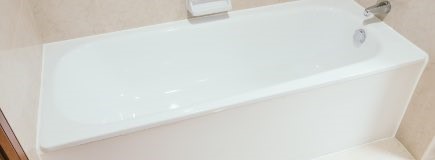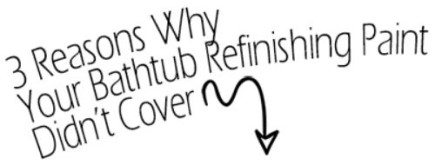Tub reglazing is a delicate process. Even if you work meticulously, damage can still occur due to faulty techniques, inadequate materials or even external conditions. Here, we'll explore some of the most common bathtub reglazing problems and explain how to avoid them.
What Are the Most Common Bathtub Reglazing Problems?
It won't take long for issues to surface if reglazing has been completed incorrectly. Here are some of the most common problems and their causes:
- Bubbling: This happens when air becomes trapped in between the individual layers of coating.
- Cracking: If cracks appear after reglazing your tub, it could indicate that the coating failed to keep water and air out.
- Peeling: If a reglazed tub is peeling, there are several factors to consider. First, the surface may not have been prepared correctly. Peeling can also occur if there's a small chip on the surface. If water seeps into the chip, it can cause the rest of the finish to loosen. This problem could also arise if the glaze isn't given ample time to cure.
- Fading: If the refinish coating is mixed too thinly, several bathtub reglazing problems can occur, including fading.
- Cratering: If water or moisture is in the spray gun when materials are applied, it can lead to bubbling. When the bubbles break, craters form in the finish.
- Delamination: This issue occurs when the top coat fails to bond to the surface, resulting in a loss of adhesion.
- Rough Texture: If the surface of the tub wasn't cleaned or sanded properly, it could result in a rough texture.
- Sticky to the Touch: If the tub feels sticky or tacky to the touch, it means the coating didn't cure properly. Should this problem arise, the bathtub should not be used until the issue is addressed.
- Chipping: Accidents can happen even after the tub has fully cured. If your client drops something hard onto the newly reglazed bathtub, it can chip the surface. This should be repaired as soon as possible to prevent further damage. It can be completed fairly quickly using a few repair materials and a blending solvent.
How to Avoid Damage When Reglazing Your Tub
Now that we've identified the most common bathtub reglazing problems, let's explore ways to eliminate these issues.
Virtually all of the reglazing tub problems mentioned above can be avoided by following a few guidelines. No matter what products you use, the reglazing process is essentially the same. When you follow these steps, your client's newly glazed tub should last 10 to 15 years.
#1: Prepare the Site Properly
Reglazing a bathtub involves harsh chemicals. Therefore, safety should be a top priority. Cover the entire bathroom with plastic sheeting and secure it with painter's tape. You must also use a fan or exhaust system to ensure that the area is well-ventilated. Keeping your client's home tidy during your project will mean less cleaning when the job is finished.
#2: Sand Down the Old Finish
Before the bathtub can be reglazed, the old finish must be entirely stripped away. Next, the tub must be sanded down, ensuring a smooth surface for the new finish.
#3: Repair Cracks, Chips or Other Imperfections
Once the bathtub has been stripped and sanded, you may notice chips, cracks, rust or other imperfections. These areas must be addressed thoroughly at this point. If this step is not completed correctly, there will be a much higher probability of post-treatment damage. Once all defects have been properly treated, you will have a quality base for the new finish.
#4: Prime, Reglaze and Coat
This step may vary slightly depending on your particular method. In general, however, a primer is applied to the surface and is allowed to dry thoroughly. Next, multiple layers of the glaze are applied. To avoid the bathtub reglazing problems explored above, it's important to allow sufficient drying time between coats. Finally, a sealing coat is applied. Note: It will take two to four days for the materials to set. Therefore, the bathtub should not be used at all until the surface is fully cured.
Weather and Temperature Considerations
As a professional, you've likely witnessed the challenges of tub and tile refinishing in cold weather. Cooler temps can make your materials thicker and much more difficult to work with. Furthermore, the coating may not cure correctly, leading to a dull finish, coating failure and other serious problems. When reglazing a bathtub, the surface temperature should be above 62º Fahrenheit and should remain at that level throughout the curing process.
Make Your Next Tub Reglazing Project a Success
Want to save time and costs on your next project? Avoid these reglazing tub problems and achieve optimal results every time.
Contact the TopKote Team


